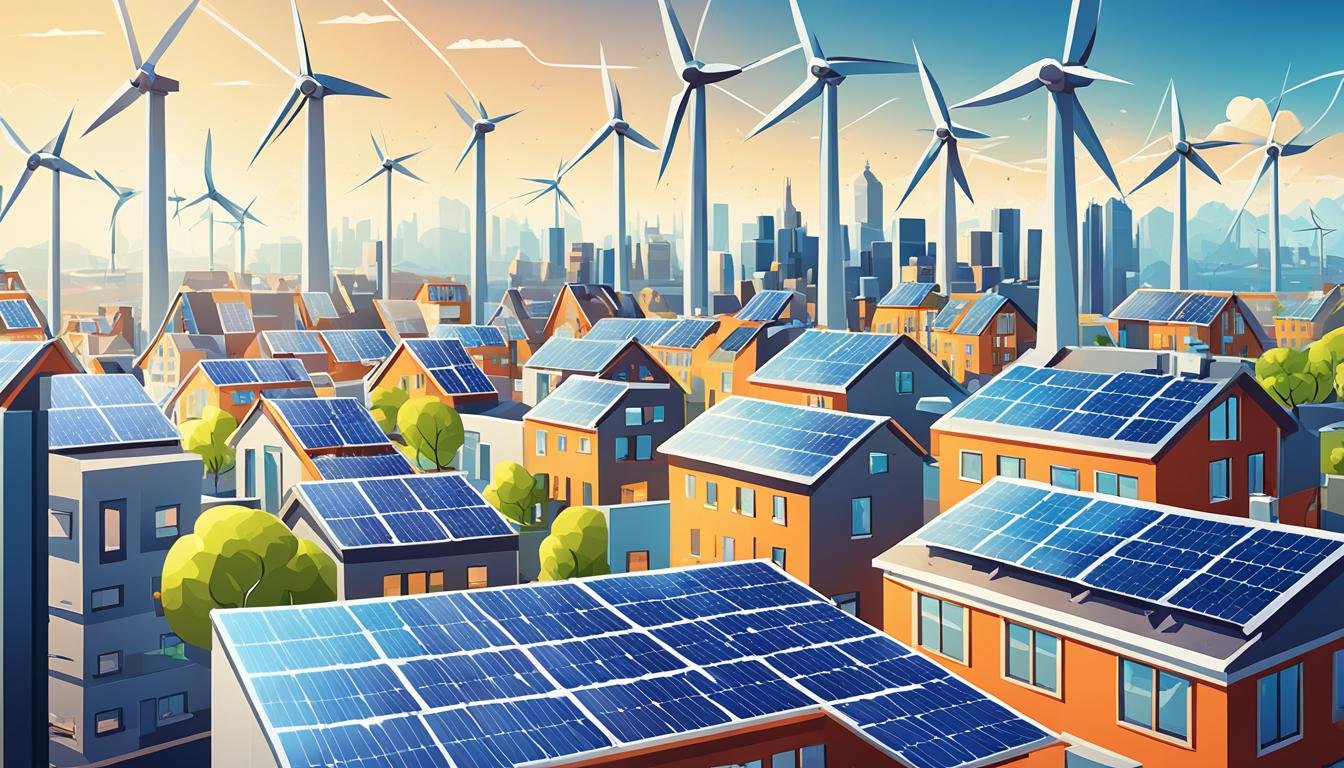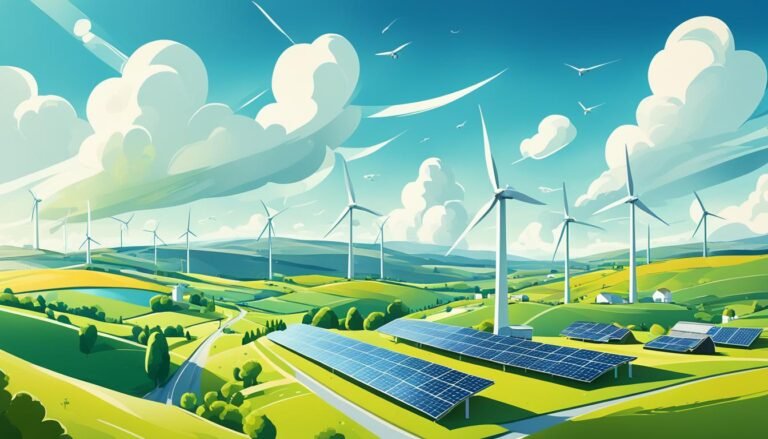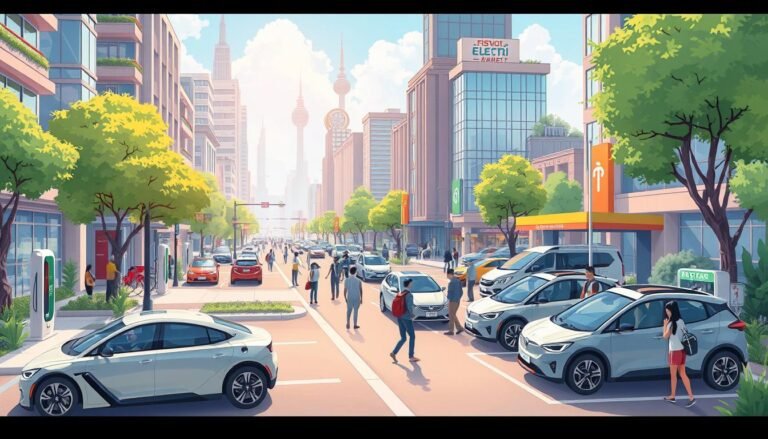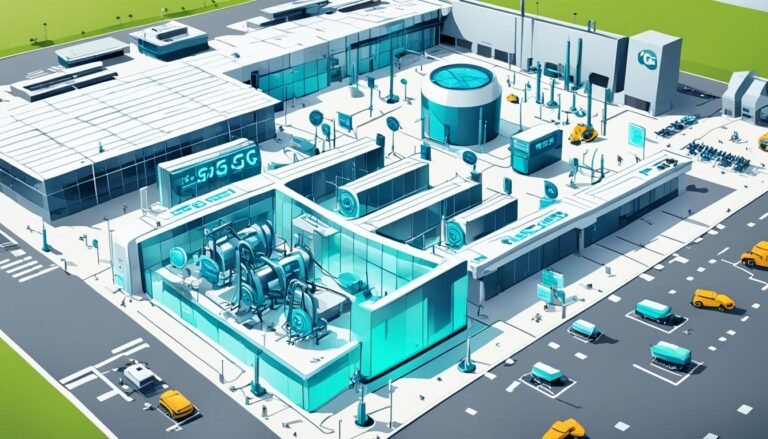Ireland’s Approach to Smart Grid Technology
What if a small island nation could lead the world in smart grid technology and renewable energy?
Ireland is stepping up as a leader in sustainable energy. It’s using smart grid solutions and renewable resources to change its energy use. By focusing on wind and ocean energy, Ireland wants a secure, low-carbon future. This plan includes new policies and tech, making it a hub for smart infrastructure innovation.
Investments in smart grids worldwide hit US$200bn from 2008 to 2015. The EU, USA, and China are expected to invest €365bn by 2020. The market for smart grid tech is set to grow to nearly US$16bn by 2020. With most of Ireland’s people living in cities, these technologies could greatly benefit the country.
Ireland aims to get 40% of its electricity from renewable sources by 2020. Big companies like ABB, Alstom, IBM, and Siemens are working on this. Being part of Smart Grid Ireland and the Smart Grid Global network shows Ireland’s dedication to smart grids.
Key Takeaways
- Ireland leads in combining smart grid solutions with renewable energy.
- Investments in smart grids are set to hit big numbers by 2020 globally and in the EU.
- With most people living in cities, Ireland focuses on smart city tech and green energy.
- Wind energy is key to Ireland’s goal of getting 40% of its electricity from renewables by 2020.
- Big and local companies are pushing Ireland’s smart grid progress.
- Being in important smart grid networks helps Ireland’s projects succeed.
Introduction to Smart Grid Technology
Smart grid technology is changing how we manage energy, making our power system more dynamic and responsive. It uses advanced monitoring and communication tech to ensure electricity is distributed and used efficiently. This change helps use renewable electricity better, making our energy supply more secure and using resources wisely.
Definition and Importance
A smart grid is an electricity network that uses digital tech to manage electricity flow from generation to use. This tech is key for better energy supply security, cutting energy waste, and adding renewable electricity sources. With real-time data and automation, smart grids balance demand and supply well, which is vital for a green energy future.
Smart grids can cut energy waste a lot. In industries that use a lot of energy, up to 15% is often wasted. With smart grid tech, these losses can be greatly reduced, leading to better energy use and saving money.
Global Context
Worldwide, the move to smart grid tech is a big step forward in managing energy. It’s driven by utilities wanting to connect new power sources like wind and solar to meet growing energy needs. Upgrading the grid makes it more stable and reliable, helping to smoothly add renewables while keeping costs down.
Countries like Denmark have seen the perks of a smart grid by efficiently using excess energy from renewable electricity sources like wind. Not investing in smart grid tech can put areas at a disadvantage, showing why it’s key to keep investing in this area. The benefits of smart grid tech could be as high as $2 trillion, far more than the initial costs.
A smart electricity network does more than just manage energy. It helps grow electric vehicles and electric heating systems, which will increase demand but reduce overall energy use. This network is setting the stage for a more sustainable and efficient energy future worldwide.
Renewable Energy Integration in Ireland
Ireland is moving towards a greener future by using its own renewable energy. It’s using wind and ocean energy to make electricity with less carbon. This helps the world move towards using less energy from fossil fuels.
Wind Energy Utilization
Wind energy is a big deal in Ireland. By 2050, wind energy could give Ireland up to 33,000 GWh of power a year. This will help meet the country’s energy needs and reduce the use of fossil fuels.
Using wind energy at the right time helps Ireland reach its renewable goals. It makes sure the country has a steady and green energy supply.
Ocean Energy Resources
Ireland also has a lot of energy in its oceans. Using this energy can increase the country’s renewable power. This helps in making the energy system cleaner.
By using wind and ocean energy together, Ireland can make its energy system more secure and cut down on CO2 emissions. This is key to a sustainable future for Ireland.
A smart grid will help make this happen. It will manage and share energy well. This way, Ireland can use all its clean energy sources efficiently, making sure the energy system is reliable and green for the future.
Grid Modernization Strategies
Ireland is moving forward with big plans for its grid. It’s using new policies and technology to meet energy goals. These efforts will make the system more flexible and allow more people to join the energy market. They will also create better communication networks.
Policy Initiatives and Goals
Policy is key to Ireland’s grid modernization. The goal is to get 80% of electricity from renewable sources by 2030. This is part of the Energy Strategy and Climate Action Bill.
By 2050, Ireland wants a zero-carbon energy system. To get there, it plans to cut energy-related emissions by 56% from 1990 levels. This means strong energy policies are needed. They must support the market, encourage using more electricity, and manage demand better. Energy storage solutions will also be part of the plan.
Technological Advancements
Technology is crucial for Ireland’s smart grid. Smart meters are a big part of this plan. They make energy use more efficient and let consumers take a bigger role in the grid.
By increasing the use of renewable energy, Ireland is getting ready for the future. This is thanks to net zero carbon goals and laws about climate change. The country aims to add more distributed generation each year to meet the growing demand for clean energy.
Investing in smart grid tech is a big deal, with plans for EUR 40 billion in Europe. The benefits could be huge, adding $1.3 trillion to $2 trillion over 20 years. This includes better generator operations, more consumer involvement, and a more reliable and secure power supply.
Energy Efficiency and Demand Response
In Ireland’s smart grid, energy efficiency and demand response are key to reaching sustainability goals. Programs that save energy and manage load are vital for better system efficiency and using more renewable energy. It’s important to teach consumers how to use smart appliances wisely.
Demand response uses price and incentives to change how people use energy during peak times. This flexibility helps the grid work better. Ireland aims to make 20-30% of its electricity flexible by 2030. Key programs include:
- Price-Based Programs: These change electricity costs based on when it’s used, during peak or off-peak times.
- Incentive-Based Programs: These give money rewards to consumers who use less energy or shift their usage during busy times.
To reach Net Zero Emissions by 2050, fast action and new technology are needed. This plan aims to add 500 GW of demand response to the market by 2030, a big increase from now.
Many technologies help achieve these goals. For example:
- Energy storage systems for homes and businesses will grow from 3.7 GW in 2020 to 510 GW by 2030.
- Smart thermostats will go from 30.4 million units in 2020 to 231.5 million units by 2030.
- Home energy management systems will increase from 4 million units to 32.7 million units by 2030.
- Heat pumps are expected to rise from 180 million units to 600 million units by 2030.
Advanced metering infrastructure (AMI) helps by giving detailed info on how much energy consumers use. This info lets utilities manage energy better, making the system more efficient. Studying how load control works with other smart grid tech shows big potential for the future.
Ireland’s focus on energy efficiency and demand response is a model for others. With ongoing innovation and getting consumers involved, Ireland is set to meet and maybe beat its renewable energy goals by 2030.
Smart Metering Deployment
Ireland is making big strides in modernizing its electric system with smart meters. These devices will soon replace old gas and electricity meters. They will make managing energy more efficient. The country has put £800 million into automated meter readers to support this change.
Smart meters offer real-time monitoring. This means people can see how much energy they use right away. It helps everyone understand their energy habits better.
This can make the grid more stable and help use energy more wisely. It also makes it easier to add more renewable energy to the mix.
In Northern Ireland, the plan to roll out smart meters is looking good. The quick rollout could bring in £301 million and make things 1.57 times more efficient. The slower approach would still be worth £71 million and 1.17 times more efficient.
The government wants every home to have smart meters by 2020. This goal is part of a big plan to update the electricity market. It aims to make prices more dynamic and engage consumers more.
Groups like BP are also helping out with projects like the Urban Energy Systems at Imperial College. These efforts show how working together can make smart metering a success. Studies have shown it’s good for the economy and society.
As smart meters spread, people will get clearer bills and more control over their energy use. They’ll also get access to new services and prices. The future is bright with smart meters leading the way to a better electricity market.
Ireland’s Focus on Cybersecurity
Ireland’s smart grid has entered a new era with digitalization. This brings big challenges, like needing strong grid security and cybersecurity standards. With smart grids getting more complex, protecting against cyber threats is key.
Cyber-attacks have shown their impact worldwide. For example, a 2015 cyber-attack caused a big power blackout in Ukraine. In the U.S., cyber-attacks on infrastructure jumped seventeenfold from 2009 to 2011. These events show how vulnerable smart grids can be.
In Ireland, the SPARKS project is tackling grid security and cybersecurity standards. It aims to improve cyber-readiness for manufacturers, policymakers, and system operators. The project works on making communication between electrical and digital data better. This helps ensure reliability, security, and efficient monitoring.
Here are some key stats on Ireland’s cybersecurity:
- A 76% jump in smart grid cybersecurity attacks in Europe from 2020 to 2021, says the European Commission.
- A 88% increase in cybersecurity incidents in smart grid systems in Ireland.
- A 62% boost in investment in smart grid security infrastructure.
- A 42% rise in research and development funds for cybersecurity in Ireland’s smart grid tech.
Researchers in Ireland are working hard to protect smart grid data from cyber threats. They focus on keeping data confidential, available, and intact. But, they know that security for IT networks won’t work for grid networks. So, they’re creating special cybersecurity standards for smart grids to lower risks.
Dealing with data attacks on the smart grid means understanding different types of attacks. These include false data injection (FDI), denial of service (DoS), malware, replay attacks, and eavesdropping. Most research looks at FDI and DoS attacks. It uses machine-learning to detect and stop these threats.
Ireland’s smart grid cybersecurity plan focuses on a “defense in depth” strategy. This means taking proactive steps and setting strict cybersecurity standards. By doing this, Ireland wants to keep its smart grid safe and resilient against new cyber threats.
Distributed Energy Resources and Their Role
Distributed energy resources (DERs) are becoming more important in Ireland’s energy scene. They include things like energy storage, distributed generation, and virtual power plants. These technologies make the grid more flexible, give power to consumers, and make the energy system more resilient. But, we need to work on some issues with rules and how people can join the market.
Types of Distributed Energy Resources
Distributed energy resources cover a wide range of technologies crucial for today’s energy world. Key types include:
- Distributed Generation: This means making electricity close to where it’s used, like with solar panels or small wind turbines.
- Energy Storage: Things like batteries store energy for later use, making the power system more reliable and flexible.
- Virtual Power Plants: These connect many small energy sources together, acting like big power plants but in a new way.
Benefits and Challenges
Distributed energy resources bring big advantages, such as:
- Enhanced Integration of Renewables: DERs, especially with energy storage, help bring more renewable energy into the grid.
- Increased Grid Resilience: By spreading out power generation, DERs make the energy grid more reliable and resilient.
- Consumer Empowerment: With tools like virtual power plants and energy storage, people can make, store, and sell their own power.
But, there are big challenges to overcome:
- Regulatory Frameworks: The rules need to change to fit the new needs of DERs and energy storage.
- Market Participation: To get the most out of DERs, we need a market that’s fair and lets everyone play and get paid fairly.
Adding more distributed energy resources is changing the way we think about power globally. With the right policies and tech, Ireland can use DERs to make a better, greener, and more efficient energy future.
Microgrid Deployment in Ireland
Microgrids are a big deal in Ireland’s energy world. They offer decentralized power generation and let local areas control their energy. Thanks to new projects and policy support, they’re becoming more common. This helps Ireland use more local energy and rely less on distant power sources.
Case Studies
The CREDENCE project ran from January 2017 to June 2021. It focused on bringing electricity and decentralizing power. This project was a big step forward for using more renewable energy, leading to 6 important research papers and lessons for rural areas.
The “EnerPort” project, from March 2018 to February 2019, worked on a new way to trade energy using blockchain. It looked at both the tech and the rules needed for this new way of trading energy in microgrids.
Future Prospects
The future looks bright for microgrids in Ireland. There’s a push to grow their use and try new things. The rise of battery storage is helping a lot, thanks to the growing DS3 grid services market.
Projects like Statkraft’s 4-hour battery show how to make the grid better and more flexible. The Irish government is also looking into long-term energy storage. This shows they’re serious about using more renewable energy and keeping the energy supply strong and reliable.
Policy Initiatives Supporting Smart Grids
Government efforts and global partnerships are pushing forward Ireland’s smart grid. They focus on programs and incentives to make energy more sustainable and innovative.
Government Programs and Incentives
The Irish government has launched many sustainable energy programs to improve smart grid tech. They use insights from the European Commission, which found 459 smart grid projects with €3.15 billion invested. Ireland aims to invest a lot in research and demonstration projects, like the EU does.
Member states, including Ireland, quickly put into action the needed laws. This created a competitive energy market. The Energy Infrastructure package (EC) 347/2013 helps by offering funding and making it easier to start projects of common interest (PCI).
International Collaborations
Ireland works with other countries to improve its smart grid. Working with the United States has been very helpful. In the US, over 14 million electric customers sent power back to the grid in 2015.
Also, in the US, businesses and industries had over 80 GW of combined heat and power in 2016. This is more than 8% of the US’s total power generation. Ireland aims to follow this success by using international best practices and global standards.
These efforts show Ireland’s commitment to energy innovation. They help Ireland build a strong and sustainable smart grid system.
Impact on CO2 Emissions and Energy Imports
Smart grid technology in Ireland greatly helps reduce carbon emissions and improve energy policy. It supports the country’s goal to cut down on CO2 emissions. This makes smart grids key for big cuts in greenhouse gases.
Statistics show that by 2020, if all energy plans are followed, Ireland could cut CO2 emissions by about 7.6 million tons a year. This move brings Ireland closer to its goal of reducing the carbon footprint.
Using more renewable energy through smart grids helps Ireland move towards a sustainable future. By 2010, energy efficiency had already made up over 26% of Ireland’s 2020 target. By 2020, energy savings could hit over 34,000 GWh annually.
This big jump in energy efficiency cuts down on CO2 emissions and helps Ireland become more energy independent. Using more diverse energy sources means less need for imports. This supports a sustainable energy shift.
Smart grids also bring big benefits to different sectors. The public sector could save 3,240 GWh by 2020, cutting CO2 emissions by 730 kt. Similar savings are expected in business, buildings, and transport sectors. Each sector’s savings help make the energy transition more sustainable and boost energy independence.
Job Creation and Economic Benefits
Investing in smart grid technology offers many economic benefits to Ireland. It creates lots of green jobs. As more infrastructure for smart grids is built, there’s a need for skilled workers. This includes engineers, IT specialists, and technicians, making the job market healthier.
Smart grids make electricity distribution much more efficient, at about 97%. This is way better than old systems, which only managed 35%. This means big savings for both consumers and suppliers.
Smart grids also help cut down energy use, which could reduce it by a lot. This is good for the environment and helps the economy grow. The Electrical Power Research Institute (EPRI) in the U.S. says smart grid tech could bring in $1.3 to $2.0 trillion in benefits over 20 years.
Electricity demand is going up fast, growing by 2% each year until 2040. This means we need to keep investing in our grids to meet this demand. Around the world, investments in electricity grids are growing by 4% a year. A big 20% of this is going to smart-grid tech as of 2014. Reports from the U.K. also show that investing in smart grid tech will bring big economic gains.
Smart grids bring lots of benefits, like more jobs, better infrastructure, and big cost savings. This mix of tech and work helps Ireland’s economy and supports sustainable growth.
Ireland’s Approach to Smart Grid Technology
Ireland is working on a smart grid roadmap for a sustainable energy future. This plan aims to cut down on carbon emissions and update the energy sector by 2050. It’s a big plan with clear goals.
National Roadmap to 2050
The National Roadmap to 2050 outlines Ireland’s energy strategy. It sees smart grid tech as key. The plan includes using more wind and ocean energy, aiming for 40 percent of electricity from wind by 2020.
It also plans to make heating and transport use more electricity. This will create a huge demand of over 36,000 GWh by 2050.
By making the electricity grid greener, Ireland could save over 13 million tonnes of CO2 by 2050. Smart grids will play a big part in these savings.
Key Stakeholders and Partnerships
Getting to these goals needs strong stakeholder engagement. Utility companies, renewable energy firms, and tech providers are key. For instance, ESB Networks aims to be carbon-neutral by 2035, showing local utilities’ commitment.
Working with groups like the European Commission is also vital. They’ve found a need for over €10bn in smart grid research by 2020. These partnerships help with the needed investments and tech for Ireland’s energy shift.
These efforts will lead to a big cut in CO2 emissions from the energy sector by 2050. It’s all about working together for a greener future.
Conclusion
Ireland is on a big journey to update its electricity grids. This effort shows its strong commitment to sustainable energy. By using smart grid technology, Ireland is making a big step towards better energy use.
This move includes using more solar and wind energy. This helps cut down on fossil fuel use and reduces harmful emissions. It’s a big step towards a cleaner future.
The government has set goals like the Climate Action Plan 2024 to help achieve this. Projects like the North Atlantic Green Zone show how different groups are working together. These efforts aim to make the energy network stronger and ready for the future.
More people are getting solar panels, and community solar programs are growing. This shift to clean energy is creating new jobs and helping the economy.
Reaching these goals needs everyone to work together. This includes the government, businesses, and the community. The current energy system is just a small part of what Ireland uses. So, moving to a renewable grid is very important.
Studies say that people’s support is key to making this change work. They must accept and use these new technologies.
In summary, Ireland’s smart grid project is a world leader. It shows how to move towards efficient and green energy. With ongoing support and investment, Ireland can reach its goal of a sustainable energy future.
Source Links
- Priority Area K: Smart Grids and Smart Cities Action Plan
- Solar Panel Installations: A Key To Ireland’s Smart Grid Vision
- News & Events – GE Smart Grid Technologies Could Transform Ireland’s Energy Landscape
- Smart Grid Ireland submission
- What you need to know about Smart Grid
- The energy transition and solar power: A critical inflection point
- Microsoft Word – 1e9b-a17d-7819-4c90
- Smart Grid Ireland Provisional Determination response
- Demand response – IEA
- A comprehensive overview on demand side energy management towards smart grids: challenges, solutions, and future direction – Energy Informatics
- Demand Response and Flexibility – Why Ireland Urgently Needs a Demand-Side Strategy
- A smarter plan? A policy comparison between Great Britain and Ireland’s deployment strategies for rolling out new metering technologies
- National smart meter rollout in planning in Northern Ireland
- Project ecosystem path
- Cybersecurity Enhancement of Smart Grid: Attacks, Methods, and Prospects
- Cybersecurity in Power Grids: Challenges and Opportunities
- State-of-the-Art Artificial Intelligence Techniques for Distributed Smart Grids: A Review
- Governance of the Smart Grid: An international review of evolving policy issues and innovations:
- PowerPoint Presentation
- EnerPort: Irish Blockchain project for peer- to-peer energy trading – Energy Informatics
- Ireland’s first 4-hour battery project indicates market evolution, challenges remain
- ISSN: 2315-4462
- Contents
- 230328_Long-term Strategy_v_eSub3
- Contact:
- A tale of three transitions: a year in the life of electricity system transformation narratives in the Irish media – Energy, Sustainability and Society








